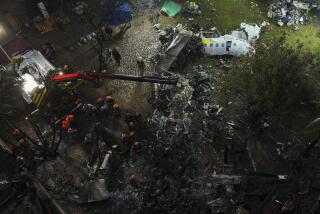FAA Bans ATR Flights in Icy Conditions : Safety: Order comes six weeks after fatal crash in Midwest. Manufacturer provides new information about possible hazards in bad weather.
- Share via
WASHINGTON — The Federal Aviation Administration, shifting its position of a week ago, ordered an immediate ban Friday on U.S. airline flights of ATR commuter aircraft when icy weather is present or forecast. The order came six weeks after one of the European-made planes crashed as it approached Chicago.
FAA Administrator David Hinson said the grounding order was based on new information from the French-Italian consortium that makes the twin-engine turboprop aircraft.
Affected by the ban are 156 short-haul aircraft in the United States operated mainly by American Eagle, Continental Express and Trans World Express. The planes, with maximum ranges of 350 to 400 miles, are produced by Avions de Transport Regional in two configurations, the ATR-42, which generally has 46 seats, and the ATR-72, with 68 seats.
“The FAA has been working day and night to develop any information about this (Oct. 31) accident,” Hinson told reporters. “The information we have now accumulated calls for immediate and direct action.”
The FAA insisted that ATRs are still safe in good weather. But officials said that new information from the manufacturer about the possible hazards of icy conditions showed that control could be lost in certain situations.
ATR, however, issued a statement late Friday arguing that its tests “provide no bases for the action taken by the FAA today.”
The company said it had voluntarily conducted rigorous tests and they “reconfirmed the full compliance of the ATR aircraft with the certification requirements set by the FAA.” The company said it continues to have full confidence “in its aircrafts’ ability to operate safely in all weather, including icing conditions.”
The Air Line Pilots Assn., many of whose members had balked at flying ATRs since the fatal crash near Roselawn, Ind., promptly endorsed Hinson’s action, calling it “justified and appropriate.”
“ATR pilots should continue to exercise their command authority and avoid icing conditions,” the association said.
A week ago the FAA held a news briefing to assure the public that ATRs were safe despite the crash that killed 68 persons.
“While some pilots have expressed concern about flying ATR aircraft, the FAA would not permit continuing operations of this aircraft if we believed the aircraft was unsafe,” Linda Daschle, deputy FAA administrator, said at the time.
Although the cause of the Roselawn crash has not yet been determined, the National Transportation Safety Board, which is investigating the accident, had recommended imposing flight restrictions for certain weather conditions.
FAA officials said Friday’s directive supplants a previous FAA order issued Nov. 16 that prohibited the operation of the ATR autopilot mechanism during icing conditions or in moderate or greater turbulence. The agency also had recommended, but not ordered, that ATRs not be flown in bad weather until the cause of the crash was determined.
In recent weeks, American Eagle, an affiliate of American Airlines, had been facing public relations problems made worse by the reluctance of pilots to fly the planes in cold, rainy conditions.
Despite the FAA’s assurances a week ago, the International Airline Passengers Assn. had urged its members to avoid traveling in ATR aircraft until the FAA took the step it decided upon Friday--prohibiting operation of the planes in known or reported icing conditions.
The government’s order, called an emergency airworthiness directive, came just two weeks before the busy Christmas travel period. But some travel agencies said airlines operating the affected planes have other aircraft to which they could shift their passengers, and thus they did not expect any major tie-ups.
American Eagle bases most of its ATR aircraft in Chicago, and Continental chiefly uses them at its Newark, N.J., hub. Airline officials said they planned to move the aircraft south as winter approaches.
Some aviation authorities said that until the October accident, ATR aircraft were generally recognized as superior planes with a good safety record and good fuel efficiency. They had proved popular with U.S. operators, handling 7% of shorter-run regional flights and 15% of regional seat capacity.
But experts now say that the ATR’s smaller, fuel-efficient wings and tail may be especially susceptible to icing. In icing conditions, water remains a liquid in the air until it encounters a surface on which it can freeze. Airplanes often provide such a surface.
Ice buildup can disrupt airflow over flight surfaces such as wings and can cause them to lose lift.
More to Read
Inside the business of entertainment
The Wide Shot brings you news, analysis and insights on everything from streaming wars to production — and what it all means for the future.
You may occasionally receive promotional content from the Los Angeles Times.










